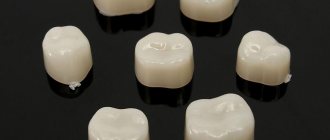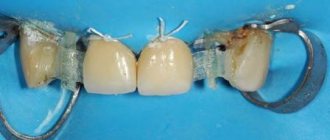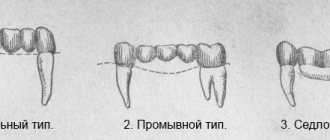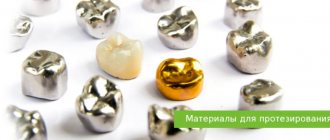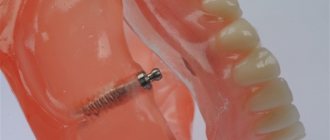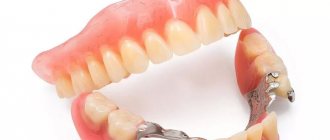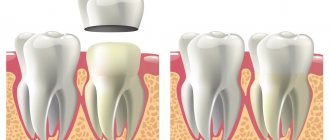A bridge is a non-removable monolithic structure of several interconnected artificial crowns that are attached to ground teeth or implants. Depending on the type of support, it can replace from 1–2 to 4 consecutive teeth.
If you want to replace an old prosthesis or are thinking about which prosthetic option to choose, the specialists of Beskudnikovo Dentistry will help you. By making an appointment with us, you will receive detailed advice and the highest quality solution to your problem.
What is this?
A bridge is a structure that consists of an artificial tooth (several) located between two crowns.
Crowns perform an important missing function and are placed on abutment teeth adjacent to the missing tooth. Such bridges are fixed using crowns, special glue and inlays, sleeves with pins. Several technologies are used in this complex process. As the name suggests, metal sleeves are used for manufacturing, from which single crowns are created; at the next stage, when soldered, they become a single whole structure.
The use of bridges is prescribed to replace missing natural teeth with artificial ones. It is used in the absence of one or several teeth in a row in a row.
Indications for installation
Like any denture, a “bridge” helps restore the aesthetics of a smile, eliminate speech defects and redistribute the chewing load in the dentition. It is an alternative to direct implantation, but is not suitable for all patients. Main indications:
- loss of 1 tooth (if there are contraindications to installing an implant);
- loss of more than 1 tooth in a row;
- replacement of a previously installed bridge prosthesis.
Installation of such a structure is contraindicated in the absence of a large number of teeth (more than 4 in a row), diseases of bone tissue (osteoporosis, osteomyelitis), chronic periodontal disease, acute inflammatory processes in the oral cavity, and malocclusion pathologies.
Advantages and disadvantages:
+ small wall thickness, and this, first of all, indicates that at the preparatory stage it will be necessary to clean a small amount of dental tissue. Accordingly, the cost, based on this, will be low.
— the main disadvantage is the lack of precision in the fit of the crowns to the teeth, due to the manufacturing features. As a result, caries develops underneath them, which subsequently leads to complete destruction. It is not uncommon for a bridge to injure the gums, leading to chronic inflammation of the gums. In the future, inflammation can lead to periodontal disease and tooth loss.
- not only a plus, but also a minus is the small thickness of the walls. They quickly lose their function due to chewing loads, wear out and break.
— the solder of the product contains metals (copper, zinc, cadmium, bismuth), which, in turn, cause adverse reactions in the body: irritation of the oral cavity, affecting the oral mucosa, provokes a disease of the digestive system and severe discomfort.
- due to the influence of saliva, metals oxidize, and an unpleasant taste appears in the person’s mouth.
— the strength of soldered products is much lower than that of solid cast structures.
— crowns have poor relief of the chewing surface due to their unevenness. These deficiencies interfere with the grinding of food and lead to problems with the mandibular joints.
Types of structures:
- Metal-ceramic.
- Adhesive.
- Solid cast.
- Stamped.
- Ceramic.
- Bridge-like structure with submerged supports.
Structure
The teeth in an orthodontic bridge are made of metal. The most commonly used are cobalt-chromium alloys. The design of this type of prosthesis implies the presence of at least 2 crowns, which serve as supporting elements.
Stamped-soldered bridges are a type of prosthetics in dentistry.
The design contains at least 2 crowns, between which an artificial tooth is located. Products are classified as chrome plated or titanium nitride coated.
If the patient experiences discomfort after installation, the deficiencies are corrected. High-quality care involves the use of home irrigators.
Between them is an artificial tooth. The prosthesis can be solid or have a lining made of composite materials or plastics (facet or insoma). Structures of the second type have low strength, they require special control and periodic modification.
The reliability of titanium stamped-brazed bridges depends not only on the quality of the laboratory’s work, but also on the health of the patient’s supporting teeth.
Medical titanium does not leave a metallic taste in the mouth and does not oxidize.
Dentist
Novikova Olga Alexandrovna
8 years of experience
The chewing surfaces of dentures should follow the natural pattern of teeth as much as possible to achieve optimal occlusion. The buccal cusps below and the palatal cusps above are especially important. They compress food and are also responsible for distributing the chewing load along the vertical axis of the bone formation.
The buccal tubercles of the prosthesis above and the lingual tubercles below are responsible for separating food, ensuring clear articulation and protecting the surface of the cheeks and tongue. They are called "protective" because of their functions.
Solid bridge
The product is made using special casting. The advantage is that the crown itself fits firmly to the ground tooth, so the places in contact with the gum and possible gaps are not clogged with food debris.
This type completely eliminates destruction. There are also disadvantages to this design. This is primarily a great sensitivity to hot. A person experiences discomfort when eating hot food.
Indications and contraindications
Orthopedic structures using the soldering method are rarely used today. But their installation is justified in the following situations:
- restoration is carried out with the elimination of medium and small defects;
- prosthetics are performed for the chewing group or incisors, with the fangs acting as a support;
- the supporting units are stable and can withstand the load of the bridge structure.
Contraindications include:
- the end elements have defects;
- three or more adjacent teeth are missing;
- there is a high degree of mobility;
- the coronal part is severely destroyed;
- enamel wear is pathological;
- there are malocclusions;
- some forms of periodontitis.
Bridge stamped and soldered
This method is considered the oldest and has been used since Soviet times. Made from a thin-walled sleeve shell. This occurs during the process of compressing a plaster copy of the tooth. At the joints they are soldered, which ensures a continuous connecting structure.
Disadvantages can be considered:
- the impossibility of creating an exact shape due to a loose fit,
- using this type of prosthetics, there is a high probability that caries will form in the future and this will lead to tooth loss,
- the walls turn out to be thin and, as a result, quickly wear off, which leads to destruction and breakage.
- Patients experience bleeding from the gums and an unpleasant metallic taste due to metal oxidation.
Manufacturing
The devices are made by compressing a sleeve with thin metal walls into a copy of the desired tooth from a hard material. The crowns are connected to each other using soldering, which makes the connection continuous. But the stamping method does not allow the tooth to be recreated with high accuracy, which is why the prosthesis does not fit tightly.
A crown resembles a cap that fits over a tooth, with cusps. The upper part of the dentures should resemble the natural chewing surface as much as possible so that the patient can eat comfortably. But due to low precision during stamping, this is not always achieved.
Bridged Maryland
In prosthetics, this design is used with submerged supports. It differs from the classic type in that not complete, but partial turning is carried out in the places selected for supports; small cavities are made there for immersing the legs of the prosthesis into them. Subsequently, the cavities are closed with fillings.
Advantages and disadvantages:
- The main positive quality of this type is considered to be preservation of the pulp and minor removal of enamel. Therefore, gum disease is excluded in this case.
- This type of prosthetics is used only if the supporting teeth are healthy.
- The prosthesis is considered ideal only for temporary restoration.
- The product itself is not durable, since the legs cannot withstand heavy loads and can become cemented.
- In modern practice, the Maryland method is used only in the front rows.
What material is used?
The stamped-soldered bridge product is made from metal alloys of noble (palladium, silver, gold) and base metals (chrome, stainless steel, nickel). For cladding, elements of acrylic plastics are used.
Indications for manufacture and use:
- various damages,
- developmental anomalies of position and shape,
- clasp support arms are incorrectly positioned,
- special support for bridges,
- treatment of tooth abrasion,
- pathological occlusions,
- dysfunction of the masticatory muscles,
- incorrect bite development,
- not large sizes of teeth. Subsequently, the cavities are closed with fillings.
Contraindications for use are:
- Defects that disrupt the orientation function of periodontal fibers.
- Defects that are associated with high mobility in the presence of a small clinical crown with a small reserve of periodontal strength. This happens with short roots.
- Diseases associated with viral infection. These are chronic diseases, such as tuberculosis, as well as a period of chronic exacerbations.
The process of preparing the dentition
Preparation begins with dental treatment and, if necessary, removal of nerves, including in the supporting teeth planned for installation. In case of severe destruction, special tabs are used to help withstand severe loads. If the indications are favorable, then the nerves are not removed.
Care
Teeth brushing should be done efficiently and daily. After each meal, hygienic treatment of the oral cavity with mouth rinse is necessary. To brush your teeth, it is more convenient to use a special brush made in the shape of a triangle with a recess.
For better oral care, home irrigators are used. Since prosthetics are carried out for a long time, the purchase of this product is justified. It allows you to avoid complications of wearing orthodontic structures (inflammatory periodontal diseases, secondary caries).
In what cases does a tooth need a crown?
Indications for the use of a crown can be for a variety of reasons:
- Elimination of tooth defects at the crown part, where it is impossible to place a filling or onlay
- Preserving a tooth from destruction
- Protection of a healthy tooth on which a prosthesis will be placed or to which a bridge will be attached
Unlike a porcelain crown, which looks much more aesthetically pleasing, a metal crown is thin. Therefore, its installation does not require extensive cutting of the tooth. It is this circumstance that makes it possible to use stamped crowns to protect healthy teeth.
If you have a problem similar to that described in this article, be sure to contact our specialists. Don't diagnose yourself!
Why you should call us now:
- We will answer all your questions in 3 minutes
- Free consultation
- The average work experience of doctors is 12 years
- Convenient location of clinics
Single contact phone number: +7
Make an appointment
COMPARATIVE ASSESSMENT OF THE QUALITY OF MANUFACTURING SOLDERED AND SOLID DENTAL PROSTHESES
V.P. Zaitsev, N.N. Stepanov, V.E. Sumkin| Fig.1. Seam structure of a soldered prosthesis |
| Fig.2. Diagram of three sections of a soldered bridge. 1 – stamped crown; 2 – solder; 3 – cast intermediate part of the prosthesis |
The history of manufacturing fixed denture structures goes back to the distant past. For example, gold dentures found in the tombs of the Etruscans, who lived in the 9th–6th centuries BC, were made using the relatively high technology of that time and were very similar to modern dentures. Unfortunately, the technology for making prostheses of that time has not reached us. It was forgotten during the Middle Ages. In this era - an era of general decline in science and culture - manufactured dentures were primitive. Only during the Renaissance did the improvement of methods for making dentures begin, which was facilitated by the significant development of jewelry art of that time.
Dentures are a temporary form of assistance. Any prosthesis, due to wear and tear and changes in the conditions of the prosthetic bed, several years after fixing it in the mouth, must be made anew. Statistics give grounds to assert that patients who have fixed dentures are made see a doctor on average after 5 years, and those who have removable dentures are made – after 3–4 years. Therefore, the population’s need for dentures is a dynamic concept. Judging by the reporting data, it is impossible to provide for everyone in need with the existing technology for manufacturing prostheses.
If we compare the data on premature tooth extraction and data on their restoration with the help of prostheses, it turns out that currently in our country, with a quite well-developed system of dental care, denture care is provided to no more than 15% of those in need. Calculations show that to satisfy the population in dentures, about 50 million dentures must be produced annually, of which about 40 million are metal-based dentures. In fact, no more than 5 million are produced annually, and the quality of the prostheses is often unsatisfactory and does not meet modern requirements.
At the same time, despite the fact that in the last decade in world practice significant progress has been made in manufacturing technologies for various designs of dentures, in Russia up to 90% of dentures are manufactured using old technologies, i.e. when individual structural elements of the metal parts of dentures are made by stamping and then connected to each other by soldering using special solders.
In world practice, soldered ones have long been replaced by solid-cast denture designs. At the same time, dental casting occupies a leading place and accounts for up to 100% in the manufacturing technology of clasp and bridge dentures, microprostheses, plate dentures with metal bases, maxillofacial and orthodontic devices, as well as other metal devices for dentures.
The introduction of foundry production in dentistry allows the manual, labor-intensive process of “riveting” metal crowns without quality guarantees to be replaced by high mechanization. Naturally, this will lead to changes in the entire technological process of manufacturing dentures. At the same time, this will make it possible to obtain a significant economic effect and, most importantly, to ensure high quality manufacturing of dentures and thereby significantly improve the provision of dental care to the population.
1. EVALUATION OF SOLDERED DENTURES
More than 70 years have passed when, in the early 30s, industrial production of stainless steel began in our country, including grades such as 1Х18Н9Т, EN-95 (Citrine alloy). After a series of special studies, Soviet scientists proposed using these steel grades as the basis for the manufacture of metal elements of dentures.
Characterizing the first works of that time on the manufacture of dentures from stainless steel, one should note on the positive side the research of S.S. Assa (1932) and D.N. Citrin (1932, 1934, 1935), who managed to create solder for stainless steels and propose a technology for connecting structural parts of various types of dentures using the soldering method.
Assessing from the position of the current level the possibilities of carrying out the technological process of manufacturing soldered bridges and the results of clinical observations, there is reason to believe that the designs of dentures are unsatisfactory from both technological and mechanical strength positions and, in addition, do not meet biological requirements.
Soldering is defined as a technological process of joining metal parts into a single structure using another alloy that has a melting point lower than the melting point of the parts being connected by 50...100 oC and has maximum affinity. To lower the melting point of the solder, elements having a low melting point are introduced into its composition, i.e. an additive is introduced.
So, for example, to connect stainless steel products, an alloy is used, which includes silver, copper, zinc, bismuth, cadmium and other elements not included in stainless steel.
The structure of the seam resulting from soldering depends on the nature of the solder and the parts being soldered (see Fig. 1). There are three types of weld structure: mechanical mixture, solid solution and chemical compound. The best of them is a solid solution. It is obtained by chemical or physical affinity of the compositions of the parts being soldered and the solder. Therefore, to connect metal parts by soldering, it is necessary to know the composition of the alloys from which these parts are made, and according to this composition, select the necessary solder, which, when combined with the alloy, forms a solid solution. An ideal seam can only be obtained by soldering with the same alloy from which the parts being soldered are composed. However, this is impossible to do in practice, since to ensure mutual diffusion, the solder must be heated until completely melted, and at this temperature the soldered parts melt and lose the required shape.
Therefore, the solder cannot be identical in physical, chemical and mechanical characteristics to the base alloy from which the prosthetic parts are composed. The solder must also have a short period of latent heat of fusion, otherwise this will lead to the fact that by the time of soldering the entire mass of solder has not yet melted, or, conversely, it will overheat and some of its components will burn out, forming a porous seam.
In addition, solders with high surface tension do not spread well over the surface of the parts being soldered and penetrate especially poorly into the narrow gaps between the parts, which deteriorates the structure of the seam and its strength.
In Fig. Figure 2 schematically shows the structure of a soldered bridge made of stainless steel, on which three sections are distinguished: crown 1, solder 2 and cast intermediate part 3 of the dental prosthesis.
The sleeve from which the crown 1 was made was drawn and then stamped. Artificial teeth 3 were obtained by casting. The junction between crown 1 and intermediate part 3 was filled with solder 2, so the structure of all sections is not identical. Of these three areas, the most unsatisfactory is the solder.
Tests of solder carried out back in the 30s at the Research Institute of Non-Ferrous Metallurgy from the point of view of the strength of the connection of soldered parts showed that the solder has satisfactory mechanical properties, although it is unstable to the effects of even weak acids.
At the same time, an analysis of the literature data, which presents the results of experimental studies and clinical observations on the effects of various solder alloys on the biological environment, gives grounds to assert that from a physical and mechanical point of view, solder does not meet the requirements for dentures located in a biological environment .
The main disadvantages of solders are their low resistance to corrosion damage in the oral cavity, the difference in the electropotential relationship with the metals being soldered, as well as changes in the structure of the metal being soldered during the soldering process.
This leads to a number of provisions that are negative.
1. Metal oxides form in the oral cavity of people who use soldered dentures made of chromium-nickel steel. Depending on the nature of saliva, the composition of other metal products present in the oral cavity (dentures, metal fillings, inlays), as well as the individual characteristics of the body, the formation of oxides can be more or less pronounced.
Blackening of solder spots or the presence of sharply defined spots on the surface of steel prostheses indicates the presence of such oxides. At the same time, in the oral cavity of people using such dentures, a quantitative increase in microelements in saliva and the formation of heavy metal salts were noted, which negatively affects the secretory function of the stomach. The mechanism of influence of metal oxides on the body during electrolytic dissociation in the oral cavity has not yet been sufficiently studied, but their non-physiological nature is quite obvious and incompatible with the principles of preventive medicine.
2. In the oral cavity of persons using soldered dentures, a pathological condition occurs, called galvanism phenomena, which are associated with potential differences and can occur both in the presence of dissimilar metals or alloys, and due to the heterogeneity of the structure of one alloy.
In the presence of soldered bridges, both factors may arise that cause a potential difference, since these prostheses consist of different alloys - chromium-nickel steel and solder, and during their manufacture the structure of each of these alloys becomes heterogeneous.
When conducting a metallographic study of soldered bridges made of chromium-nickel steel, it was revealed that even with careful adherence to the technology, there are many unsoldered areas along the entire contact line. Micropores are found in the layer of solder separating them. Reducing the thickness of the solder layer, although it provides a stronger connection of the soldered parts, does not improve the structure of the alloy at the place of their connection, and the number of micropores in the solder layer in this case even increases. Both in the crown and in the intermediate part a two-phase steel structure is observed. There are areas of metal with precipitation of chromium carbides along the grain boundaries of the metal.
It is impossible to improve the structure of the alloy by heat treatment (recrystallization), since for this the prosthesis must be heated to a temperature of 1,000–1,100 °C, and this will lead to deformation and separation of its parts.
As a result of the phenomena of electrolytic dissociation, porosity and unsoldered areas, insufficient strength is created. This leads to a reduction in the period of use of such prostheses due to the separation of the intermediate part from the crowns.
From a mechanical point of view, soldered prostheses are not strong enough. During the soldering process, crowns and artificial teeth heat up most in the melting zone of the solder, and individual sections of the bridge heat up to a lesser extent. Uneven heating changes the structure of the crystal lattice of the cast intermediate part of the prosthesis. For example, chromium-nickel stainless steel changes its phase state at the soldering point at a temperature of 900 °C. In somewhat distant areas in the temperature range of 600–800 oC, precipitation of carbides dissolved in the alloy occurs. In areas located even further away, the compound of carbon and chromium is concentrated. The metal becomes brittle. The formation of a two-phase structure, in turn, causes the occurrence of intercrystalline corrosion, which intensifies with mechanical load of dentures in the electrolyte environment of the oral cavity, as a result of which bridge dentures break.
In addition, after soldering parts of the prosthesis, the total result of shrinkage of the solder leads to significant deformation of the frame of the bridge, which makes it difficult to fix it in the oral cavity.
From numerous literature data it is known that from a biological point of view, the quality of soldered prostheses is also unsatisfactory. Solder is sufficiently stable only in alkaline environments. In an acidic environment, which often occurs when eating food or due to changes in the pH of saliva, solder is unstable and chemically active elements are released from it. Thus, the concentration of iron, cadmium, copper, bismuth and other elements in human saliva can often exceed the norm by more than three times. In combination with other elements that make up saliva, they cause the occurrence of non-physiological electrolytic processes in the oral cavity. Due to the structural variety of the areas of soldered prostheses, the difference in potentials often exceeds 100 mA, and this can cause such symptom complexes in patients as a metallic taste, a burning sensation of the mucous membrane, a perversion of taste, etc. Electrolytic dissociation, in turn, enhances the corrosion process metals and leads to the formation of new oxides. In addition, solder oxides diffuse into the plastic lining of the crowns of artificial teeth and change their color.
From a technological point of view, when producing crowns by stamping, there is an inappropriate change in their thickness in different areas. During the process of drawing and stamping sleeves, the areas in the transition area between the chewing and cutting surfaces become thinner the most. Then, in these same areas, the metal is significantly ground off during machining and polishing. As a result, the thickness of the side wall of the crown between the equator and the gingival margin is almost 2 times greater than the thickness in the area undergoing the most treatment.
If we consider the clinical stages of manufacturing stamped-soldered prostheses, they provide for up to 5 patient visits to the doctor:
1 visit:
Preparation of teeth and taking impressions for the manufacture of stamped and soldered crowns.
2nd visit:
Trying on stamped crowns and their adjustment, as well as taking an impression to make the soldering of the intermediate parts of the prosthesis (cast teeth).
3rd visit:
Trying on unpolished stamped-soldered bridge structures and their adjustment.
4 visit.
Fitting of polished stamped-soldered structures of bridges and structures with their subsequent fixation.
5 visit.
When spraying dentures, the production of dentures takes from 20 to 30 days.
Thus, analyzing the above, we can draw the following conclusions, namely:
1. Currently, stamped crowns and soldered bridges do not meet the necessary modern requirements, since the stamping technique does not allow for accurate production of the crown.
2. The presence of dissimilar alloys and metals in a soldered bridge prosthesis leads to the phenomenon of galvanism in the oral cavity.
3. At the place where denture elements are soldered, breakage very often occurs.
4. The manufacturing process of various elements of a stamped-soldered denture involves the use of strong acids.
2. EVALUATION OF SOLID DENTURES
As mentioned above, the method of making solid dentures from gold has been known for a long time, but due to the high cost it has not received mass distribution.
Modern dental prosthetics is developing in two directions:
1. Research and use of materials that would have certain physicochemical, mechanical and biological properties, but at the same time would be cheap and available for mass use.
2. Individual production of a denture design that would most fully and optimally compensate for the defect in the dentition.
In this regard, in dental practice, metal alloys are used, parts of which are made by preliminary individual modeling of reproductions from modeling materials with the subsequent replacement of these reproductions by precision casting.
Therefore, a major role in the manufacture of dentures that meet modern requirements for them belongs to foundry processes for the production of dental casting.
However, it should be noted that casting metal parts of a denture is a complex technological process consisting of the following stages:
– making a wax reproduction of the part (wax model);
– installation of gates and creation of a casting block;
– preparation of the mixture used to form the facing layer of the model;
– covering the wax reproduction of the part with a facing mass;
– production of injection molds;
– melting wax from the casting mold, followed by drying and firing of the casting mold;
– melting of a dental alloy followed by pouring the molten metal into a casting mold;
– cooling the casting with its subsequent release from the molding mass and gates;
– if necessary, heat treatment of cast parts.
– polishing, fitting, etc.
Consistent and careful implementation of the above stages of manufacturing denture parts using the lost-wax casting method is a guarantee of ensuring high quality of the cast denture part, which can only be achieved by carefully performing the listed points in accordance with existing techniques.
It should be especially emphasized that to ensure high-quality production of metal parts of dentures, the method of melting the alloy from which the part is cast is important.
In dental practice, various methods of metal melting are used: electric arc melting, oxygen-acetylene flame melting, electroslag casting, and high-frequency casting. Melting metal with an electric arc and an oxygen-acetylene flame is an open type of melting. In the first case, the temperature regime is maintained using electrodes made in the form of graphite coals; in the second, melting occurs due to direct contact of the flame of a burning mixture of acetylene and oxygen with the melting metal. Melting metal in electric furnaces using high-frequency currents is a closed type of smelting.
However, despite the fact that the above methods of metal melting make it possible to provide the required temperature sufficient to melt alloys used in dental practice, the structure and properties of these alloys after casting change significantly.
For example, when melting chromium-nickel steel with an electric arc, the percentage of carbon and oxygen in the alloy increases, and on the microsection many foreign inclusions are found, which by their nature can be attributed to oxygen and carbon compounds. On microsections of parts cast using a high-frequency furnace, foreign inclusions are not detected, and the structure of the alloy is close to homogeneous.
When interacting with a 50% solution of hydrochloric, acetic or lactic acid, castings are highly stable after melting in high-frequency electric furnaces. Castings after melting with an electric arc are less resistant to acids, which is explained by the increased content of carbon and Eoxygen in these samples.
The results of a study of melting cobalt-chrome steel using an electric arc or an oxy-acetylene flame showed that the content of carbon and oxygen in it increases (carbon content often exceeds 0.4%). When melting the same grade of steel in high-frequency furnaces, the percentage of carbon in the alloy does not change significantly.
The nature of cooling of the alloy after pouring into the mold has a significant impact on the hardness, ductility and uniformity of the metal structure.
High hardness, low ductility and pronounced heterogeneity of the alloy structure (presence of carbide formations) are observed during slow cooling of the casting. With rapid cooling, the alloys retain a single-phase state without visible carbon inclusions, low hardness and good ductility are noted. This is explained by the fact that when the casting is slowly cooled, there is enough time for diffusion processes to occur, promoting the formation of carbide systems. With rapid cooling, this process is suppressed and carbides do not have time to form. Consequently, to ensure a homogeneous structure of the alloy after casting and maintain its high physicochemical and mechanical properties, it is most advisable to smelt the metal in high-frequency casting-melting furnaces, followed by rapid cooling of the cast parts.
High frequency induction melting machines provide higher casting quality. First of all, carburization and burnout of some components of the alloy are eliminated, the gap between the period of complete melting of the metal and its pouring into the mold is eliminated, and this eliminates the need for higher heating of the alloy after melting in order to compensate for the cooling of the mass during the period of connecting the cuvette to the injection mold. The molten alloy fills the hot mold under high pressure of centrifugal force, which makes it possible to compensate for the shrinkage of the alloy by expanding the molding mass when it is heated. In addition, the constant pressure of the centrifugal force exerted on the cooling metal sharply reduces the possibility of the formation of shrinkage cavities, which arise due to the fact that the outer surface of the metal has already hardened and a hard crust has formed, while the inner one is still cooling and a mass rupture is obtained, i.e. sink. When casting dental parts in centrifugal casting installations, the alloy is poured into a mold heated to 800–900 °C, so it cools more evenly. The greater the difference in temperature heating of the mold and the alloy, the greater the number of shells, while overheating of the alloy is allowed no more than 100 °C above its melting point.
Thus, dental casting requires maximum attention even if all basic foundry rules are carefully followed. Cast parts or prostheses must be subjected to appropriate additional processing to improve their quality.
As already indicated, to ensure uniformity of the alloy structure, cast parts should be subjected to rapid cooling. However, even with rapid cooling of castings at a temperature of 600–800 °C, some heterogeneity in the alloy structure may occur. Firstly, at this temperature the most favorable conditions are created for the combination of carbon and chromium (formation of chromium carbides). This manifests itself more intensely, the higher the percentage of carbon in the alloy. Secondly, during rapid cooling, not all iron has time to transition from the $- to -state, and therefore is in a two-phase position. All this increases the electrical activity of prostheses and reduces their strength.
The resulting heterogeneity of the alloy structure can be eliminated by heat treatment of the part or prosthesis, if they have not been soldered and the percentage of carbon in them is within acceptable values.
When carrying out a metallographic examination of solderless bridges cast in chromium-nickel stainless steel, immediately after casting and after appropriate heat treatment in the intermediate links of the prostheses that have not undergone heat treatment (especially in the crowns of these prostheses), a two-phase structure of the steel is revealed. There are also areas of metal with precipitation of chromium carbides, which reduces the mechanical and physicochemical properties of the metal, causes intercrystalline corrosion and increases the electrical potential of prostheses.
The accuracy of casting, the smoothness of its surface and the purity of the alloy depend both on the heat resistance, dispersion and other qualities of the facing layer, and on a number of other factors. An important role is played by the change in the shape of the metal during the transition from the molten state to the solid state (shrinkage). Shrinkage of the metal or alloy is inevitable in foundry technology, but it can be compensated for by selecting a molding compound that has an expansion coefficient that is closest to that of the alloy. It should be remembered that the expansion coefficient of the molding mass depends not only on the physical properties of each of the ingredients, but also on the degree of heating, as well as on the amount of plasticizer taken to dilute the mass.
Molding compounds, the basis of which are quartzites, have the greatest expansion when heated to a temperature of 800–900 oC. The greater the degree of expansion, the less water is taken to dilute the mass, i.e. the denser the consistency of the dough. With large dilutions of the molding mass with water, maximum expansion is observed at a lower temperature, but the degree of expansion is significantly lower compared to a densely diluted molding mass.
To achieve the greatest thermal expansion of the mold, necessary to compensate for metal shrinkage, it is advisable to use dry quartz sand as an external filler for the casting mold.
From a mechanical point of view, cast abutment crowns that are part of a solid-cast bridge do not have the elastic deformation inherent in stamped crowns and soldered bridges. Cast dentures sag less, which creates conditions for reliable protection of the aesthetic coating made of plastic or metal-ceramics. When making crowns, it is possible to create zones of local thickening by layering wax, which provides mechanical resistance to the perception of functional load.
From a biological point of view, one-piece prosthetic structures also have advantages. The homogeneity of the metal structure and the absence of solder ensure a decrease in the intensity of electrochemical processes in the oral cavity and a decrease in the amount of microelements washed out into saliva, which can act as haptens and have an allergic effect on the human body.
Clinical studies give reason to believe that in many patients who come to the clinic with symptoms of galvanosis, after removing soldered dentures from the oral cavity and fixing solid dentures made from the same alloy, the phenomena of metal intolerance disappear.
In addition, the clinical stages of manufacturing solid dentures, compared to the clinical stages of manufacturing stamped-soldered dentures, involves only three visits, namely:
1st visit: Preparation of teeth, taking impressions for the manufacture of temporary protective structures and fixation of temporary protective structures.
2nd visit: Fitting of polished solid cast structures and fixation of the prosthesis.
3rd visit. When spraying dentures, the production of dentures takes from 3 to 10 days.
From a technological point of view, the advantages of solid-cast bridges are undeniable. Lost wax casting in industry all over the world is currently one of the most promising processes for processing metal into products of complex shapes. Currently, in most dental industries in the world, the soldering process is excluded. For more than 30 years, the curricula of foreign universities that train dental specialists have not included a section on the technology of manufacturing soldered denture structures.
Thus, from the above comparative analysis of the manufacture of dentures using the stamping method followed by soldering and the casting method, the following conclusions can be drawn:
1. Producing dentures by casting makes it possible to obtain more uniform properties of the metal of the denture, which eliminates electrochemical processes in the oral cavity;
2. Dentures allow you to most fully compensate for the defect in the dentition, since cast crowns are more accurate, tightly cover the neck of the tooth and do not injure the gum tissue;
3. Dentures are reliably protected by aesthetic coatings made of plastic or metal-ceramics.
4. The mechanical strength and chemical resistance of dentures increases, and, consequently, their service life.
5. The introduction of casting technology into dental practice makes it possible to reduce the number of both clinical and laboratory stages in the manufacture of solid-cast bridges, which allows not only to obtain a significant economic effect, but also to significantly improve the quality of manufacturing dentures.
6. The technology for manufacturing solid-cast bridges does not involve the use of strong chemicals (acids, alkalis, etc.), which improves the working conditions of dental technicians.
7. When organizing proper and high-quality training of foundry technicians, the production of dentures using the lost-wax casting method allows several times to increase the productivity and efficiency of dental technicians.
